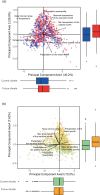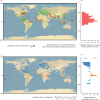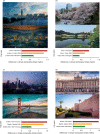Understanding climate change from a global analysis of city analogues
- PMID: 31291249
- PMCID: PMC6619606
- DOI: 10.1371/journal.pone.0217592
Understanding climate change from a global analysis of city analogues
Erratum in
-
Correction: Understanding climate change from a global analysis of city analogues.PLoS One. 2019 Oct 16;14(10):e0224120. doi: 10.1371/journal.pone.0224120. eCollection 2019. PLoS One. 2019. PMID: 31618246 Free PMC article.
Abstract
Combating climate change requires unified action across all sectors of society. However, this collective action is precluded by the 'consensus gap' between scientific knowledge and public opinion. Here, we test the extent to which the iconic cities around the world are likely to shift in response to climate change. By analyzing city pairs for 520 major cities of the world, we test if their climate in 2050 will resemble more closely to their own current climate conditions or to the current conditions of other cities in different bioclimatic regions. Even under an optimistic climate scenario (RCP 4.5), we found that 77% of future cities are very likely to experience a climate that is closer to that of another existing city than to its own current climate. In addition, 22% of cities will experience climate conditions that are not currently experienced by any existing major cities. As a general trend, we found that all the cities tend to shift towards the sub-tropics, with cities from the Northern hemisphere shifting to warmer conditions, on average ~1000 km south (velocity ~20 km.year-1), and cities from the tropics shifting to drier conditions. We notably predict that Madrid's climate in 2050 will resemble Marrakech's climate today, Stockholm will resemble Budapest, London to Barcelona, Moscow to Sofia, Seattle to San Francisco, Tokyo to Changsha. Our approach illustrates how complex climate data can be packaged to provide tangible information. The global assessment of city analogues can facilitate the understanding of climate change at a global level but also help land managers and city planners to visualize the climate futures of their respective cities, which can facilitate effective decision-making in response to on-going climate change.
Conflict of interest statement
The authors have declared that no competing interests exist.
Figures




References
-
- Nisbet EC, Cooper KE, Garrett RK. The Partisan Brain Suhay E, Druckman JN, editors. Ann Am Acad Pol Soc Sci. SAGE PublicationsSage CA: Los Angeles, CA; 2015;658: 36–66. 10.1177/0002716214555474 - DOI
-
- Zaval L, Cornwell JFM. Effective education and communication strategies to promote environmental engagement. Eur J Educ. 2017;52: 477–486. 10.1111/ejed.12252 - DOI
-
- Kahan DM. Climate-Science Communication and the Measurement Problem. Polit Psychol. Wiley/Blackwell (10.1111); 2015;36: 1–43. 10.1111/pops.12244 - DOI
-
- Marx SM, Weber EU, Orlove BS, Leiserowitz A, Krantz DH, Roncoli C, et al. Communication and mental processes: Experiential and analytic processing of uncertain climate information. Glob Environ Chang. Pergamon; 2007;17: 47–58. 10.1016/J.GLOENVCHA.2006.10.004 - DOI
Publication types
MeSH terms
LinkOut - more resources
Full Text Sources
Medical
Research Materials
Miscellaneous

